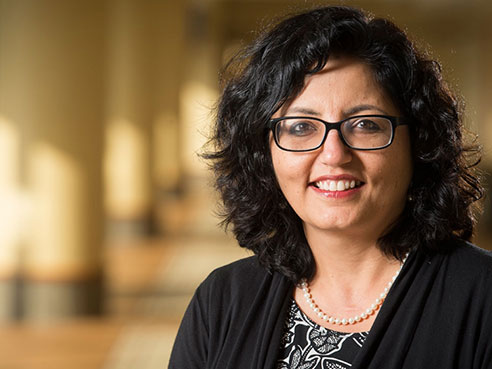Written by Matt Windsor
This article is adapted from a video interview with Dr. Bhatia on UAB’s MD Learning Channel. Even after cancer is defeated, it can cast a lifelong shadow. “Cancer survivorship represents a very critical phase,” said Smita Bhatia, M.D., M.P.H., a pediatric oncologist and director of the new Institute for Cancer Outcomes and Survivorship in the UAB School of Medicine and associate director for cancer outcomes research at theUAB Comprehensive Cancer Center. “We and others have shown in our research studies that our cancer survivors are a vulnerable population,” she said. “When you follow them long-term, you find that they have a very high burden of chronic health conditions.”
Even after cancer is defeated, it can cast a lifelong shadow. “Cancer survivorship represents a very critical phase,” said Smita Bhatia, M.D., M.P.H., a pediatric oncologist and director of the new Institute for Cancer Outcomes and Survivorship in the UAB School of Medicine and associate director for cancer outcomes research at theUAB Comprehensive Cancer Center. “We and others have shown in our research studies that our cancer survivors are a vulnerable population,” she said. “When you follow them long-term, you find that they have a very high burden of chronic health conditions.”
Often, these health problems can be linked back to cancer treatments, including chemotherapy, radiation and even surgeries, Bhatia said. Because these complications can occur “many years after the completion of treatment,” they are called “late effects.” One example involves a particular class of chemotherapy drug known as anthracyclines. “We use these agents often because they are highly effective in a large variety of cancers,” Bhatia said. But research shows that patients who take these drugs have a high risk of developing congestive heart failure many years later.
Girls who have “received radiation to the chest around puberty for lymphoma,” have “an increased risk of breast cancer,” Bhatia added. And this breast cancer “occurs at a much younger age than would be anticipated in the general population. So these girls are developing breast cancer at age 30 and 40, whereas in the general population you’d be anticipating breast cancer at age 60.”
Results from a survey have shown that only a third of patients realize they are at risk for these late effects, and because the family practitioners and internists who are seeing these patients do not encounter cancer survivors very often, “it is not in the forefront in terms of their understanding, in terms of their knowledge base and in terms of their experience of what they should anticipate,” Bhatia said. Addressing this situation becomes even more urgent as the number of survivors grows, she adds. “The number of cancer survivors is growing at the rate of about 2 percent every year,” Bhatia said. “We will, by about 2022, have 18 million cancer survivors.”
| “In order to provide the most comprehensive long-term care to our survivors, we need care plans. These “are essentially a summary of all the treatment that the patients received for their particular cancer, along with recommendations for long-term follow-up in order to detect complications.” |
That is why UAB is establishing special survivorship clinics. “In order to provide the most comprehensive long-term care to our survivors, we need care plans,” Bhatia said. These “are essentially a summary of all the treatment that the patients received for their particular cancer, along with recommendations for long-term follow-up in order to detect complications.”
The idea, Bhatia said, is to lay out “a roadmap for our cancer survivors for life. That’s what I would like to do for all our cancer survivors who are coming to UAB, no matter what diagnosis they have, no matter what their age is, from here on.”
Survivorship clinics are staffed by physicians, nurse practitioners, social workers, psychologists, and dietitians, “who provide absolutely comprehensive but very tailored care to the survivors,” Bhatia said. “So we would, for example, do heart tests in order to detect heart failure at an earlier stage only amongst patients who’ve received treatments that are toxic to the heart. Mammograms would be recommended for patients who’ve received radiation to the chest at a young age, and who are at risk for breast cancer.”
This “very tailored but anticipatory screening” is designed “to detect these complications at an earlier stage,” said Bhatia.
The same survivorship model can now be extended to care for patients with many different chronic health conditions, Bhatia says. These include patients with sickle cell disease, HIV, congenital heart disease — “any chronic condition where the health care providers can really coordinate the care of the patient as a whole, the entirety of their health, and provide complete and comprehensive care long-term.”